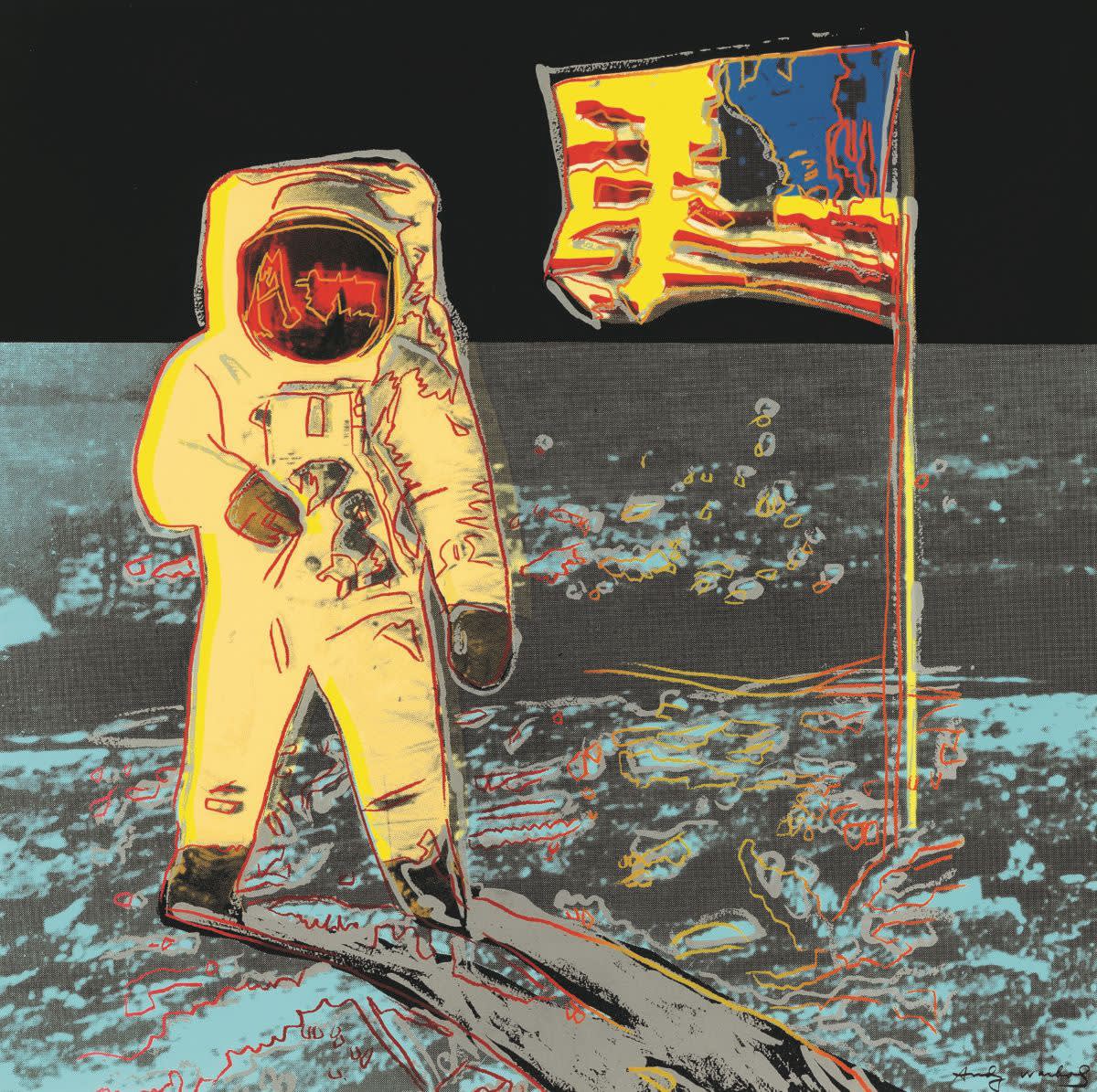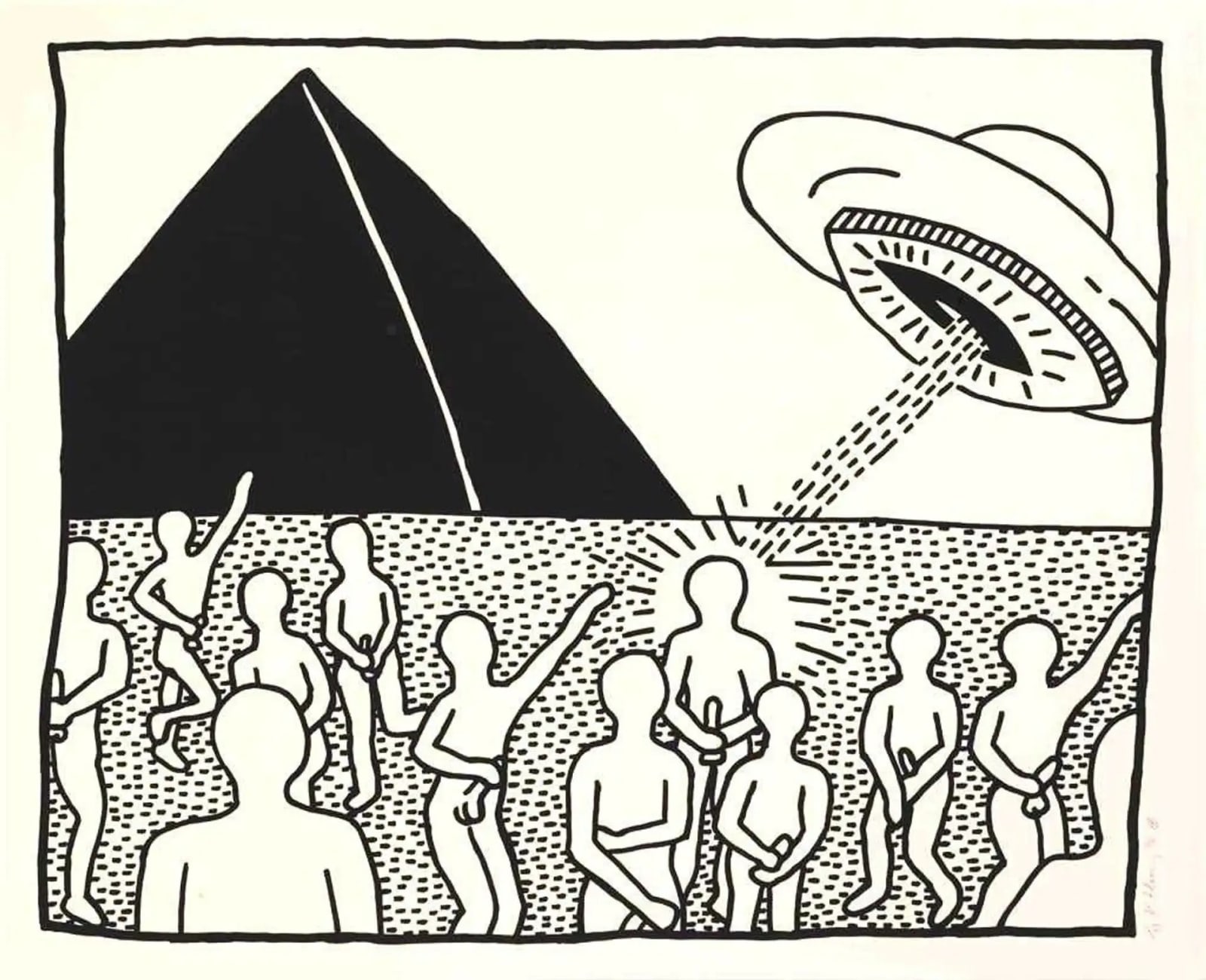
Forms in Space - Roy Lichtenstein

Roy Lichtenstein's Forms In Space, created in 1985, was commissioned for the Philadelphia Institute of Contemporary Art's annual theme-based fundraiser, which focused on national emblems and values. This signed screenprint on BFK Rives paper, produced in an edition of 125, features a pop art interpretation of the American flag, underscoring Lichtenstein's significance in the American art scene by this point in his career. Like Jasper Johns before him, Lichtenstein tackled the challenge of representing the American flag, a powerful national motif.
At first glance, the image resembles the familiar American flag, but upon closer inspection, Lichtenstein has made notable alterations. He distorts the stripes, adjusting their angle and increasing their number, and replaces the flag’s iconic white stars with rows of blue Ben-Day dots on a white background. Despite these changes, the composition’s use of bold, uniform colours and flat planes makes it instantly recognizable. Through this mechanised interpretation of the flag, Lichtenstein challenges traditional perspectives, encouraging viewers to reconsider their relationship with national symbols.
Characteristic of Lichtenstein’s pop art style, Forms In Space features bold primary colours, large Ben-Day dots, and solid contours. His subversive take on the American flag parodies the media and critiques the fragility of national symbols. By titling the piece Forms In Space Lichtenstein highlights society’s reliance on universal symbols, while simultaneously capturing the spirit of the 1980s, the decade in which it was created.
A recurring theme in Lichtenstein’s work is the blurred boundary between illusion and reality, and Forms In Space showcases his talent for reimagining iconic imagery. The piece reflects the ever-evolving nature of contemporary art, as Lichtenstein masterfully reinvents a symbol deeply ingrained in American culture.
Moonwalk - Andy Warhol

Moonwalk is a portfolio of two screenprints created by Andy Warhol in 1987, the same year of his passing. These prints, made by the iconic Pop artist, were originally intended to be part of a portfolio titled The History of TV. They depict astronaut Buzz Aldrin standing beside the American flag on the surface of the moon. What sets this work apart is that the image is not a still from the televised moon landing, but a photograph taken by Neil Armstrong himself. This use of a rarely seen photograph, combined with the late placement in Warhol's career, makes Moonwalk an exceptional addition to his body of screenprints.
In these prints, Warhol applies a vibrant, fluorescent colour palette typical of the 1980s, bringing a futuristic and energetic feel to the historic moment of the moon landing. In a playful personal touch, Warhol subtly incorporates his own initials into the reflection in Aldrin’s visor. This adds a layer of self-referentiality and humour, blending the artist’s identity with the famous image. The overall effect of Moonwalk is holographic, reminiscent of the way the landing was first experienced through television.
Though the moon landing occurred decades earlier, the 1980s saw a resurgence of space-themed culture, with television, science fiction films, and space-inspired graphics dominating popular media. It is fitting that Warhol, always a forward-looking artist, would create a work celebrating space exploration at this stage in his career. As with many of his prints, Moonwalk merges the fame of the artist with that of the subject. Buzz Aldrin himself reflected on this in his autobiography, mentioning how one of Warhol’s Moonwalk prints hangs in his home, highlighting the connection between Pop culture and historic achievement. Explore Andy Warhol prints for sale.
Space Girl and Bird - Banksy
Measuring 59cm by 112cm, No.5, Space Girl and Bird transcends its physical dimensions, transforming into a profound statement on the themes of isolation and connection—an ongoing exploration in Banksy’s work. Known for his elusive persona and sharp social commentary, Banksy uses this piece to create a world where the central figure—a girl in a helmet—becomes a striking symbol of the technological barriers separating humanity from nature. Through this artwork, Banksy invites reflection on the broader societal challenges of our time. The helmeted figure is more than just an aesthetic choice; it represents a deeper commentary on the human experience. While the helmet serves as protective gear, it also acts as a metaphorical wall, cutting the wearer off from their surroundings and, by extension, from life’s true essence.
In Space Girl and Bird, the girl’s isolation is underscored by her grip on a bird—a symbol of freedom and natural beauty. The bird’s vibrancy contrasts with her stark, industrial helmet, creating a powerful visual representation of the tension between protection and isolation. This juxtaposition evokes a profound reflection on modern life, where increasing digitization and technological advancements often distance us from the natural world.
Banksy masterfully contrasts innocence with industrialization through the oversized helmet. The girl cannot connect with the bird, a symbol of nature, because of the artificial barrier separating them. This imagery echoes a recurring theme in Banksy’s work—the corrupted relationship between humans and nature, where beauty and freedom are often obstructed by the impositions of modernity. The girl's obscured face heightens this sense of detachment, symbolising the anonymity and isolation often fostered by the protective layers of modern society. This motif extends beyond the physical, touching on the emotional and psychological barriers that people build in their attempts to cope with the complexities of contemporary life, much like Banksy’s own efforts to shield his identity from the public eye.
UFOs - Keith Haring

Haring's use of UFOs often appeared alongside other recurring symbols in his art—radiant babies, barking dogs, flying saucers, and figures in motion—each representing different elements of modern life and societal issues. In many cases, Haring’s UFOs hover above human figures, appearing to control or abduct them. This evokes the sense of an overwhelming, omnipotent force, much like the role of technology and military power in the Cold War.
The UFO in Haring's work can be seen as a metaphor for the complex and often unseen powers that dominated society in the post-war period—government surveillance, the arms race, and the looming threat of space-based warfare. Haring's art, which often critiqued authority and systemic control, used UFOs as a playful yet biting commentary on how technology, particularly space exploration and military advancements, was wielded as a tool of dominance and control.
Another interpretation of Haring’s UFO imagery in relation to the Space Race is how it reflects the growing divide between humanity and technology. During the Space Race, technological advancements were celebrated as markers of progress, but there was also growing concern about the loss of human connection and the impact of technology on society. Haring’s UFOs, like much of his work, can be viewed as a critique of dehumanisation. The UFO, often depicted as distant or unapproachable, suggests a sense of alienation that comes with technological dominance. The figures beneath these UFOs are sometimes helpless, echoing fears that humans were losing control over their own destiny in an age dominated by machines, computers, and rockets.
In this sense, Haring's work aligns with other contemporary critiques of the Space Race that questioned whether the technological race to conquer space was overshadowing more urgent issues like civil rights, poverty, and human connection. His UFOs, thus, can symbolise the seductive yet dangerous allure of technological progress when it is divorced from human values.
However, while Haring’s UFOs carry critical undertones, they also reflect a sense of wonder and possibility. The UFO, as an emblem of the unknown, can be interpreted as a symbol of future possibilities, much like the Space Race itself. Haring was often fascinated by the idea of the future, new worlds, and transformative change. In his vibrant, energetic style, UFOs can also symbolise a utopian hope for the future, where humanity could transcend its earthly problems and make contact with something larger than itself.
This duality—UFOs as both a symbol of oppression and of potential—mirrors the complex attitudes of the time toward space exploration. The Space Race was not just about political rivalry; it was also about human curiosity, the search for knowledge, and the desire to expand beyond the confines of Earth. Explore Keith Haring prints for sale.
For further information on any of the artists or artworks featured, contact sales@andipa.com or call +44 (0)20 7589 2371.
